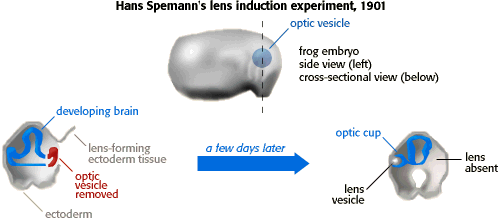
Developmental Mechanisms Problem Set
Problem 4 Tutorial: Role of the optic vessicle in embryonic lens development
| The formation of the lens from the ectoderm layer during frog embryonic development is dependent upon signals received from the underlying optic vessicle. This is an example of: |
|
In 1901, Hans Spemann published the results of his lens ablation experiment, one of the most significant papers in the history of embryology. With this experiment, Spemann was the first person to provide evidence of embryonic induction. Embryonic induction in when one tissue induces a neigboring tissue to develop into a particular structure. 
In his experiment, Spemann cauterized the optic vessicle in a frog embryo during the neurula stage of development. The resulting tadpole had a missing eye and lens on the side where the optic vessicle had been removed, although the other eye developed normally. Without the inducing characteristics of the optic vessicle, the ectoderm never became placode tissue. In normal development, the placode tissue goes on to induce the formation of the optic cup, which in turn induces the placode tissue to form the cornea and lens of the eye. |
The University of Arizona
Thursday, October 30, 1997
Contact the Development Team
http://www.biology.arizona.edu
All contents copyright © 1996. All rights reserved.






